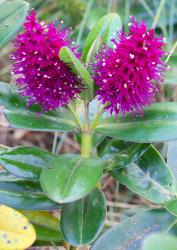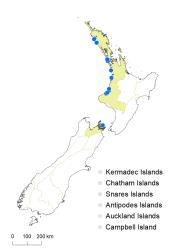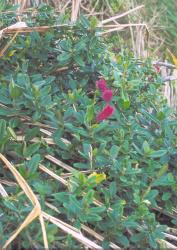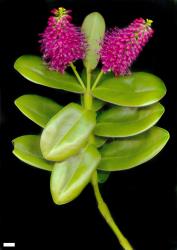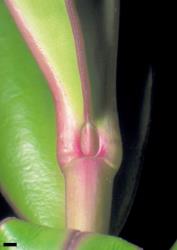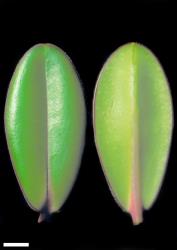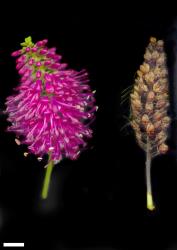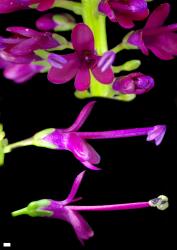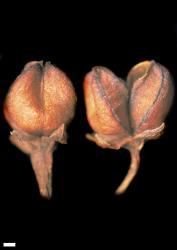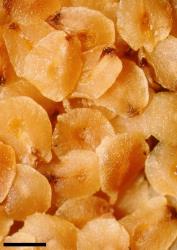- Taxon
- Gallery
- ≡ Hebe speciosa (R.Cunn. ex A.Cunn.) Andersen, Trans. New Zealand Inst. 56: 693 (1926)
Spreading low or bushy shrub, usually to 1 m, rarely to 2 m tall. Stems spreading to ascending or pendent, glabrous. Leaf bud distinct, its leaves appressed at margins until fully grown; sinus small and elliptic to rounded. Leaves opposite-decussate, erecto-patent to spreading; lamina coriaceous, elliptic to obovate, 45–100 mm long, 21–51 mm wide, glossy green or dark green above, dull pale green or green beneath; midrib and secondary veins evident; surfaces eglandular-hairy along midrib above and often beneath, sometimes glabrous beneath, sometimes covered in minute glandular hairs; margin usually puberulent, sometimes including glandular hairs or sometimes glabrous, entire; apex obtuse, truncate, or slightly retuse; base truncate or sub-cordate; petiole 1.5–6.0 mm long. Inflorescence a lateral raceme, 40–145 mm long; flowers crowded, 32–116, all bisexual; bracts alternate to loosely whorled, the lowest sometimes opposite, ovate to deltoid, ≤ pedicels; pedicels erecto-patent to spreading, sometimes recurved at fruiting, 1.0–6.5 mm long, sparsely to densely eglandular-hairy all around. Calyx lobes 4, obtuse to acute, 2.5–3.2 mm long, sub-equal, eglandular-ciliate or mixed glandular- and eglandular-ciliate. Corolla 5–8 mm diameter; tube magenta, 2.5–4.0 mm long, ≥ calyx, eglandular-hairy inside; lobes 4, magenta, erecto-patent to spreading, unequal, elliptic to ovate, 3–6 mm long, obtuse to rounded, nectar guides absent. Stamen filaments magenta, 7–13 mm long; anthers magenta. Style glabrous, 6.5–15 mm long. Capsules latiseptate, sub-acute to obtuse, glabrous or eglandular-hairy along septal groove, 3.5–7.0 mm long, 3.5–6.6 mm at widest point. Seeds broadly discoid to ellipsoid, flattened, smooth, pale brown to brown, 1.1–1.9 mm long.
Veronica speciosa plants are very distinctive and characterised by their large, thick, shiny leaves and their large and robust magenta flowers. V. punicea is the only other species that is characterised by magenta flowers, but V. punicea plants can be distinguished from V. speciosa by longer corolla tubes (up to three times the calyx and longer than the lobes), leaf bud without a sinus, branchlets very shortly puberulent, pedicel hairs much shorter, and leaves usually narrower and tapering to the apex. In addition, V. speciosa flowers have ciliolate corolla lobes, a rare feature in New Zealand Veronica seen also in the white-flowered V. rakaiensis.
North Island: Northland, Auckland, Taranaki (scattered west coast localities from Hokianga to North Taranaki). A record from Matiu/Somes I., Wellington, is not considered to be indigenous there.
South Island: Marlborough Sounds (Titirangi Bay, Pelorus Sound). Several recorded populations are believed to be extinct (Armstrong & de Lange 2005).
Coastal sites, usually on cliffs and rock outcrops. Recorded elevations range from 0 to 360 m.
Naturalised on sea cliffs in Ireland (Walter & Webb, in Tutin et al. 1972) and a cultivation escape in Hawaii (Wagner 1990).
Wild hybrids are not known, but in cultivation V. speciosa hybrids are highly valued because it is a source of intense flower colour (magenta, purple, and pink). The commonest is V. ×franciscana ‘Blue Gem’ (V. elliptica × speciosa). Some hybrids of cultivated origin may spread from cultivation or be inadvertently planted in revegetation projects.
Flowers: January–November; fruits: January–July, persisting all year.
2n = 40 (see Bayly & Kellow 2006, as Hebe speciosa).
Veronica speciosa is classified in V. subg. Pseudoveronica sect. Hebe and the informal group “Apertae” (large-leaved) (Albach & Meudt 2010; Bayly & Kellow 2006).
According to Armstrong and de Lange (2005), the three northernmost populations (those north of Auckland) contain most of the genetic diversity of the species. They suggested the more southern populations might have originated from transplantation and cultivation by Māori.



